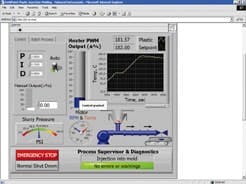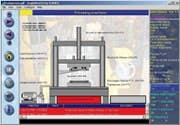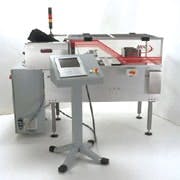Although web-based systems for maintaining the power distribution infrastructure and power quality are both highly developed and commonplace in the utility industry, production and machine builders have been slow to adopt the same technology and apply its benefits to their system and machine designs.
Figure 1: Looks Familiar
The browser-based interface has a familiar feel to it,
and providing a stepping off point for applications
that provide remote monitoring of machine and process
conditions. Source: National Instruments.
Why the dichotomy? In just about any commercial or industrial setting, the pace of the migration to new technologies is influenced by business conditions, market environment and a whole host of other circumstances. Regardless of a given technology's potential, there are always early adopters, the wait-and-see crowd and outright refuseniks.
Nevertheless, the relentless pursuit of efficiency, competitive advantage and cost containment are prompting the production and machine building crowd to more carefully consider browser-based technologies to meet those same benchmarks for their customers.
Cost and Convenience
First, let's take a look at why users are adopting such systems. Building on what was previously done with modems and proprietary interfaces, a web-based approach can provide a lower total cost of ownership. It starts with lower installation costs, because users already have most of what they need.
MDC Engineering (http://www.mdcengineering.com), Sarasota, Fla., manufactures blister machines for the pharmaceutical and medical industries. "Web-browser technology is inexpensive to use and most people have a standard browser on their computers," says Michelle Bergeron, controls engineer for MDC. "This enables them to monitor real-time data without special or expensive software. In addition, an Ethernet-based TCP/IP network is open, which makes it easier [than proprietary networks] to integrate into existing plant networks."
The advantages and attractiveness of a browser-based solution may have its roots in traditional SCADA environments. Amerada Hess Corp. (http://www.hess.com), New York, is a full-service energy company, well-known throughout the world. "We were looking at replacing a legacy SCADA system," says Joey Bordelon, automation consultant at Amerada Hess. "The browser made this easy for us. Internet Explorer is already there, as was the IT infrastructure to run it." To provide the browser-based interfaces, then, Hess just used more of what they already had.
Initially, machine builders added browser functionality (Figure 1) to facilitate troubleshooting and software upgrades. Subsequent reductions in downtime cost-justified the initial investment. But, for some, the relationship with browser technology didn't stop there.
A Deployment Platform
Iconics (http://www.iconics.com) is a provider of visualization software for industrial automation and business intelligence. "Web-based HMI allows a centralized deployment platform," says Tim Donaldson, Iconics marketing manager. "Displaying the HMI within a browser allows users to leverage existing hardware."
How about system life cycles? Older systems running on Windows NT are at an evolutionary dead-end, because NT no longer is supported, or even available for purchase. If you need to update one component, you could face considerable sticker shock when the bill comes in for the upgrade.
Berkeley Process Control (http://www.berkeleyprocess.com/) makes control components and markets turnkey control installations to the semiconductor industry, among others. "A browser allows freedom from operating systems," says Lenson Wong, director of marketing. "Some customers invested many man-years in developing a system running on Windows NT. That significant investment now requires a large porting effort after only a few years of use."
Figure 2: When You Need To Know
With web services, companies can open up the
operating information throughout the factory and make
it available to the authorized personnel who need to access it
Source: Iconics
Had those systems been built on a browser-based platform, the owners, as well as the machine builders who provided them, might not be facing obsolescence problems or the costs associated with resolving them. At the time, the browser-based platform wasn't really a viable option. Today, it is.
Click Here for Expertise
When users grant web-based access to vendors and machine experts, this type of support can serve customers more fully and more quickly at less cost. Users, builders, consultants and manufacturers are all saying the need for system expertise is akin to a craving that never seems quite satisfied.
Essco Electric Sales and Service (http://www.esscoinc.com) is a distributor and integrator of Beijer Electronics operator interface (OI) products. Applications engineer Robert Spencer would love to have access to customer data via remote OI screens, e-mail enabled alarming, and FTP server access. "These very powerful features could save us a lot of travel time and money," he says. He laments the cultural issues that keep his company at odds with his customers' IT people and their concerns over security. This is a key issue, one that has done much to squelch widespread early adoption.
Dresser-Rand (http://www.dresser-rand.com), Olean, N.Y., has been providing industry with energy conversion technology for more than 100 years, with compressors, steam and gas turbine packages, and control systems, from initial concept to equipment retirement. Constantine Lau, marketing and business development manager for condition monitoring at Dresser-Rand is concerned about the brain drain that's coming. "Most of the machinery gurus I talk to are 60-plus," he says. "What will happen when they retire during the next few years? Remote monitoring and access will help companies deal with this. The web makes communication easier."
Better communication is something software developers are trying to answer with products that provide an information conduit between machine experts and the factory floor. Wonderware(http://www.wonderware.com) Lake Forest, Calif., produces software with advanced abilities to view, analyze, and work with process information. "With better security and web tools, machine builders and users have expanded their relationship," says Renee Brandt, product manager for visualization. "It now includes predictive maintenance, better integration with other hardware and software, and access to problem-solving information."
Machine builders now can easily provide and/or access real-time information such as runtime hours, vibration, oil levels, temperatures, and pressures (Figure 2). Users can plan maintenance more efficiently and prevent failures.
Everyone should enjoy the simpler software maintenance and update processes that result. Rather than maintaining thousands of lines of code, users would get the same browser updates the IT department implements. And browsers make some functions very easy to add. "Among the several features that browsers make possible are e-mail-enabled alarming with timestamps and diagnostic information, and connectivity to the FTP server which allows remote access to alarm log files, trend files and recipes," says Essco's Spencer.
Up From the Factory Floor
Increasingly, company managers want information from the factory floor (Figure 3). Web-based systems can meet that need. Invie Consulting (www.4invie.com), Moorhead, Minn., provides automation consulting for applications across the enterprise." Their services include CAD work, programming, and interface design. "With [the web interface], we have been able to place more operator stations onsite for our customers and increase their management's ability to see what is happening internally and remotely," says Luke Graunke, project engineer with Invie Consulting. "Updates are much easier, thanks to the screens being stored on a server rather than on individual machines located throughout a plant."
Figure 3: Say Goodbye To Sneakernet
Managers increasingly want information from the factory floor,
and they want it in real time,they do not want to wait for
paperwork to flow to their offices by traditional sneakernet methods.
Source: Iconics
Non-technical Barriers
The primary reasons for not adopting browser-based technology appear to be non-technical. Topping the list is security. The concern over this issue has two facets: fear of unauthorized control of the equipment, and fear of unauthorized access to proprietary information. Good deployment of existing technology answers these concerns. "The technology is available to provide a secure network, but an additional layer of design is involved," says Jon Ford, president of machine builder MDC Engineering, (http://
www.mdcengineering.com) Sarasota, Fla. So, it's not just plug and play. Users who look at a potential application without that additional layer probably will reject the web approach.Wonderware's Brandt says many companies are not making this information available through the Internet, but over their intranets. Package Machinery Corp. (www.packagemachinery.com), West Springfield, Mass., took the intranet approach. The company builds overwrapping and bagging machines. "We put all of our new control systems on our intranet," says Kevin O'Connor, director of engineering. "We can use our control software from anywhere inside our facility. I also have a VPN connection to my home."
There are costs, however. Advantech (http://www.advantech.com), Fremont, Calif., supplies hardware and software automation products and services,including web-based supervision appliances,to a wide range of industries. "You have your network infrastructure in place anyway,that's not going to be a cost adder," says Matt Jacks, senior software engineer at Advantech. "But, the system requirements to operate a browser efficiently are higher than for your average DAQ unit."
Maintenance cost is another concern voiced by many when it comes to embracing browsers. But, adding a networked browser should decrease maintenance costs, since the physical architecture is simplified.
Samuel Jackson Inc. (http://www.samjackson.com), Lubbock, Texas, makes moisture control systems and related products for the cotton industry throughout the world. The company does its own fabrication and forming, pneumatic design, wiring, control code, electronics design, assembly, and testing. "With the web approach, you're running a single CAT-5 cable," says Mark Gentry, manager of controls and communications. "Compare that to methods that require 20 individual wires from the machine to the control console." The result for many industrial machine builders is a simpler, leaner machine (Figure 4).
Figure 4: Untangled Solution
With the web approach, a single Cat5 cable can replace
many require individual wires from the machine to control console,
machine to machine, and machine to monitoring stations.
Source: MDC Engineering
Why else do people hesitate? "Some cultural issues come into play," says Dresser-Rand's Lau. "People want to protect their knowledge. Or they are used to doing things a certain way and don't want to change."
People also form views based on the type of work they do, e.g., they might work in a regulatory environment or where risk aversion is crucial. Eclipse Combustion (http://www.eclipsenet.com), Rockford, Ill., knows all about that. It offers products and systems for industrial heating and drying applications, including gas and oil burners, recuperators, heat exchangers and combustion systems. "I deal mostly with safety systems where standard practices and codes may not allow control by browser technology,or any remote control," says Dan Curry, product engineer at Eclipse. Typically, the benefit would be for annunciation and diagnostics only."
Technically Speaking
Cubex Controls (http://www.cubexcontrols.com), Ft. Mill, S.C., specializes in flexible factory automation for a wide variety of industries. Its systems often use the latest advances in factory automation and software design, and they have experience with browsers. "Connection costs are minimal," says Bruce Sigman, PE, senior systems integrator at Cubex. "Usually, the company already has a high-speed Internet connection and an IT group responsible for it. It is now just a matter of pulling CAT5 cable and connecting to the existing network."
Thanks, But No Thanks
Sometimes a company is simply satisfied with the HMI technology they have. This is the case with Surface Finishing Technologies (SFT,http:// www.technic.com/tec/sft.htm), Clearwater, Fla., a manufacturer of continuous vertical electroplating systems for the metal finishing, printed circuit, and flexible circuit industries. SFT specializes in advanced automation and customized material handling. "We have few requests for remote HMI access," states Kim Ground, senior automation engineer for SFT. His current system does all he wants it to, just as it is.
Some users look at the results and functionality, rather than the means to achieve them, and don't see a need to change. That's the case with Leggett & Platt (www.leggett.com), Carthage, Mo., designs and produces a variety of engineered components for residential furnishings and aluminum engine parts. "We are basically able to do anything with dial-up, since it is our application that communicates to our machines," says Jim Bodanza, special projects engineer. "I can't think of anything we need a web browser for. However, everything we can do via a dial-up can be done via the web."
And, some users balk at the browser approach simply because they haven't seen a good implementation. Varco Intl. (www.varco.com), Houston, manufactures high-performance oilfield equipment and provides related services that improve oil rig reliability. "My experience is that most people cringe when they hear the words browser-based HMI," says David Cardellini, director of controls engineering for Varco. "That's because few people have invested what it takes to make this work flawlessly and faster than thick-client solutions. Usually, the browser port is a half-baked add-on to an existing thick-client app with the intent for remote access only." Cardellini believes that all it takes is a quick demo of a high-performance implementation to change a user's mind.
Cardellini says it's under control. "Three years ago, we designed our own controller using single-board computers, Linux and Java," he states. "This simple machine is headless [like a PLC] and has access only through a browser. All diagnostic screens and operator screens are hosted on this controller, along with control code for sophisticated robotic and machine control, with up to 30 screen updates per second." He says Varco has more than one hundred systems operating worldwide in critical operations. "Even our most pragmatic customers (e.g., Shell, BP) are willing to take these newer systems," continues Cardellini. "A quick demo, with the customer's PC talking to one of our controllers across the Internet, makes a compelling case,there's no special software install required."One concern raised is the potential to overload a network with data. While bandwidth is theoretically an issue, in reality it need not be. In the power quality arena, vendors handle this by keeping raw data off the network and sending only useful information. This is being done with industrial machines, too. You don't need continuous updates to every measurement. You primarily need the delta and trending of key points. "You must determine what is worth monitoring and what is not," warns Lau."
Where We're Headed
There's considerable sentiment that browsers are here to stay, given the growth in Ethernet-based data solutions. "Give it another 10 years, and most industrial control communications will be via Ethernet," predicts Gentry. "I say this because while the cost of the hardware is greater, the labor savings more than make up that cost."
Xycom Automation (http://www.xycom.com), Saline, Mich., is an HMI supplier. "Those who just collect data and limit control capabilities are the early adopters," says Gary Labadie, Xycom product manager. "Slowly, but surely, more control applications will come on board. We keep seeing consumer innovations like Ethernet, flash, and wireless find their way into industrial applications. The next wave will be full multimedia implementations from digital manuals embedded into the machine and viewed from a browser. We may go so far as to have voice recognition so we can call the machine from a cell phone and ask it for a report."
Leaders relevant to this article:







